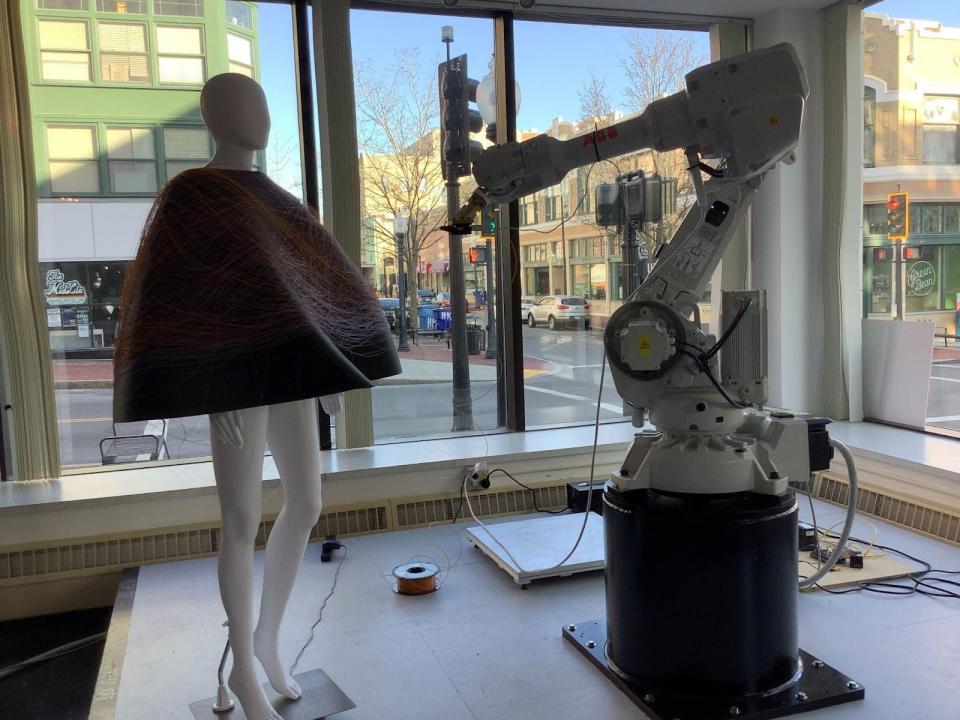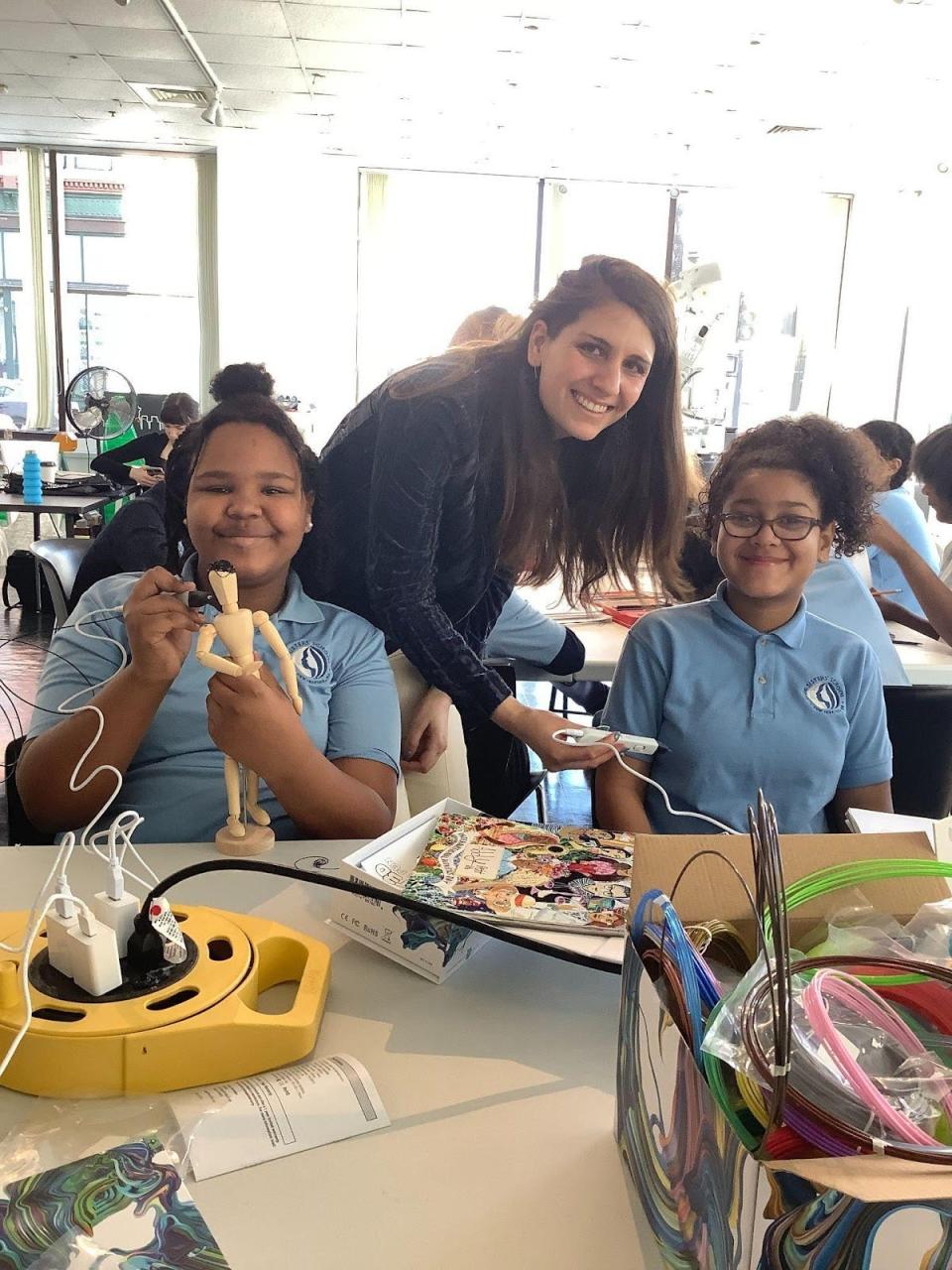High fashion goes high tech in downtown New Bedford
NEW BEDFORD — "I take a lot of inspiration from technology," says Israeli grad student Lilach Porges of her work as a fashion design student.
As she planned her final project in earning her MFA from the Fashion Institute of Technology in New York, Porges was looking for an opportunity to leverage advanced technology in her craft — a journey that brought her to New Bedford to take advantage of New Bedford Research and Robotics' (NBRR) unique resources.
Porges, 28, says she's been interested in fashion design since she can remember.
"One of my strongest childhood memories is when I cut and connected fabrics on my body in my room around the age of 10," she said, noting the passion she developed for high-level math and computer science during her high school years.
Robotics takes Porges from New York to New Bedford
Years later, as a grad student in New York, Porges decided to try a different approach to fashion design — one that would combine the two areas she was passionate about.
"I had the idea to create a fashion design collection with a robotic arm," she said. "Because I could not afford to purchase a robotic arm as a student, I started emailing every person in the area who might have one to loan."

Luckily for Porges, she ended up finding NBRR founder and Executive Director Mark Parsons, a New Bedford native and resident, when Parsons was living and working in New York City at his first robotics-based business, Consortium for Research and Robotics.
"Then when Mark opened the NBRR, we kept in touch and decided to continue collaborating," Porges said.
See the latest local news:New Bedford's Ash Street Jail records chronicle 100 years of criminal history. Now what.
How it works
In order to use this cutting-edge method of creating garments, one has to know a bit about programming, Porges said.
"The robotic arm in the exhibition followed a circular line repeatedly that I created by coding with the softwares Rhino and Grasshopper," she said. "A 3D pen tool connected to the robotic arm printed PLA (plastic) material. The rest of the exhibited garments were printed in advance with a material named Braskem GR605R-CF which is a polymer that contains 90% of recycled materials, including recycled bottle caps and recycled carbon fiber."
But the actual production of the garments isn't the only area of Porges' methodology where she's incorporated advanced technology.
"It can also be experiments that I'm doing with the technology; for instance, I explored drawing dresses around myself in virtual reality with Oculus Quest 2."
Inspiration rubs off on OSS students
Last week, middle schoolers from Our Sisters' School in New Bedford had a chance to visit Porges in her work space at the CVPA Swain Studio on Purchase Street, where she'd been using all those skills — and NBRR's high-tech robotic arm named "Splinter" — to 3D print her project piece.
During OSS students' trip to the studio last week, the girls got to see the robotic arm in action as it produced one of Porges' designs, as well as have a 3D design experience of their own using 3D pens to create physical models of their ideas.
"I presented how I work with a 3D pen by hand, and they all designed garments with the 3D pen on small mannequins — just the way I did when I started my research at FIT," she said, commending the students for the "brilliant questions" they came up with.

"It was inspiring for me to see how inspired they were. It made me feel more confident with what I do when I saw how fascinated they were with my work."
"I love fashion, but my time working with Lilach ... and NBRR is making me love it even more," said OSS 6th grader Amarie C.
"I learned that a small roll of filament can make an entire outfit, no matter the size," said OSS 6th grader Melen A.
“Witnessing OSS students in these workshops has been inspiring," said Parsons. "They are engaged, unafraid of creative risk, and the OSS students take ownership of their work."
Learn more about NBRR:Window to the future: New Bedford man looks to make robotics lab at former Glaser Glass
Collaboration by design
Providing experiences like the one enjoyed by the OSS students last week are part of the philosophy of NBRR and OSS, as both place emphasis on community collaborations and partnerships.
“Partnerships like the one between NBRR and OSS are essential," said OSS Creativity Director and STEAM teacher Tobey Eugenio, who also serves as STEAM consultant/advisor to NBRR. "Learning deepens and has a lasting impact when experiences are layered with exposure to mentors, real-world tools and challenges, build a sense of personal agency and generate a sense of wonder.”
The OSS field trip, as well as another 3D modeling workshop held for undergraduate fashion students of UMass Dartmouth, were built into Porges' week-long stay as part of NBRR's Artist in Residency program.
Conflict continues at ORRCommunity members hit back at ORR official over radio, meeting comments
Next for Porges
Porges, who has since returned to New York, says she's set to graduate in May and hopes to continue collaborating with NBRR.
"In the future, I hope to drive my project into a start-up of wearable fashion that has less impact on the environment and minimizes labor," she said, noting that in the meantime, she plans to start applying for fashion design work in New York City. "There's a lot of research to be done until then, but I'm ready to begin."
This article originally appeared on Standard-Times: Robotics used to bring fashion designs to life in New Bedford

